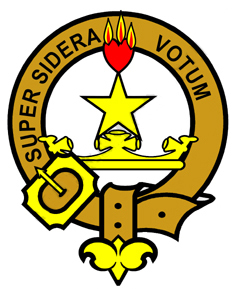Rattray Clan
Rattray Clan Crest: Issuant from a crest coronet, a molet, ensigned by a flaming heart, all Proper.
Rattray Clan Motto: Super Sidera Votum (My desires extend beyond the stars).
Rattray Clan History: This surname is taken from the Barony of Rattray, “Raith Tour”, meaning “Hill Fort”, which was acquired by followers, but not a Sept, of the Murrays of Atholl. According to tradition, the Rattrays acquired their lands from Malcolm Canmore in the 11th century, although the first recorded bearer of the name is Sir Thomas de Rattray, son of Alanus of Ratheriff, who married the heiress Christian of Aberbothric in 1253, the same year that he became embroiled in a dispute with the Abbot of Arbroath.
In 1296, Eustace de Rettref was taken prisoner at Dunbar Castle, and possibly as a result of this, Sir Adam de Rotrefe rendered homage to Edward I. Originally, Rattray Castle was situated on a site further down Glen Ericht but, in the 16th century, the clan moved to the clifftop fastness 200 feet above the River Ericht to defend themselves against John Stewart, 2nd Earl of Atholl, who was greedy to acquire their lands.
In 1463, Sir Silvester Rattray of Rattray, who sat in the Scottish Parliament, was one of the feudal barons who negotiated peace with England. He inherited estates around Fortingall in Atholl from his Stewart mother, a daughter of one of Alexander Stewart, the Wolf of Badenoch's many natural sons. Sir Silvester's son, Sir John Rattray, was killed at the Battle of Flodden in 1513, and his Stewart cousin of Atholl took the opportunity to sack Rattray Castle and to carry off Sir John's two young granddaughters, whom he subsequently adopted as his 'wards'.
Their own father had been killed while soldiering in Europe, and there was no-one to prevent the abduction. The Earl of Atholl then arranged for one of the girls to marry his son, claiming half the Rattray lands as her dowry, and he forced the other girl to hand over the other half she theoretically possessed.
Meanwhile, their uncle, Sir John's second son, Patrick, had taken refuge in the densely wooded hills north of Blairgowrie and it was he who began the building of a fortress on the site of the present house. for a while, this Patrick was able to evade the Athollmen, but in 1533 they caught up with him and he was killed as he took refuge in Kinballoch Chapel.
At this point, the Earl of Atholl's niece, Marjory Stewart, the widow of Kininmonth of that Ilk, announced that she had fallen in love with Silvester Rattray, Patrick's remaining brother. She then married Silvester and persuaded her uncle to return the Rattray's rightful inheritance. Her wishes granted, Rattray descendants have lived ever since at Craighall Castle, which was named after her first husband's tower in Fife.
Some forty years later, at the time of the Restoration, Craighall was completely re-modelled by another Patrick Rattray, whose lands were made into one Free Barony under 'Craighall-Rattray' in a Charter from Charles I.
In 1727, Thomas Rattray, Laird of Craighall, became Bishop of Dunkeld. His academic studies were a major influence on the re-writing of the Scottish liturgy.
In the 1745 Jacobite Uprising, the Rattray Chief refused to support Prince Charles Edward Stuart, but contributed £50 to the cause. His brother John, however, became the Prince's physician and, after the Battle
of Culloden, was only saved from the scaffold by the intervention of his golfing friend, Lord President Forbes.
In 1799, the Rattray lands and name passed to a cousin James Clerk, Sheriff Depute of Edinburgh, who was a close friend of the writer Sir Walter Scott. Sir James Clerk Rattray, 26th Laird of Craighall-Rattray, became a
General and, in 1897, was awarded the Order of the Bath.
Like many Scottish families, Rattrays have found their way to the far corners of the world – notably South Africa, the USA, New Zealand, Canada and Australia.
Surname distribution in Scotland: The Rattray surname is most commonly found in Perth and Kinross (Perthshire and Kinross-shire), Highland (an amalgamtion of Caithness, Inverness-shire, Nairnshire, Ross and Cromarty, Sutherland and small areas of Argyllshire and Morayshire), Aberdeen City, Aberdeenshire (includes Kincardineshire and part of Banffshire) and Moray (Elginshire).
Places of Interest: Craighall-Rattray, Blairgowrie, Perthshire. Sir Walter Scott stayed as a guest at Craighall and modelled 'Tully-Veolan', the fictional Baron of Bradwardine's castle in Waverley, on the house.
Rattray Clan membership certificates.

